The global ophthalmic prefilled injectables market is valued at USD 1,784.6 million in 2025 and is slated to reach USD 4,342 million by 2035, recording an absolute increase of USD 2,557.4 million over the forecast period. This translates into a total growth of 143.3%, with the market forecast to expand at a compound annual growth rate (CAGR) of 9.3% between 2025 and 2035. The overall market size is expected to grow by approximately 2.43X during the same period, supported by increasing demand for targeted retinal therapies, growing adoption of anti-VEGF treatment protocols across ophthalmology and hospital sectors, and rising preference for convenient pre-filled delivery systems in clinical settings.
The ophthalmic prefilled injectables market represents a specialized segment of the global pharmaceutical delivery industry, characterized by clinical innovation and robust demand across ophthalmology clinics, hospitals, and ambulatory surgical centers. Market dynamics are influenced by evolving retinal treatment paradigms toward targeted biologics, growing interest in minimally invasive delivery technologies, and expanding partnerships between pharmaceutical companies and ophthalmic specialists in developed and emerging economies. Traditional multi-dose vial systems continue evolving as clinicians seek proven prefilled alternatives that offer enhanced dosing accuracy and reliable therapeutic characteristics.
Treatment behavior in the ophthalmic prefilled injectables market reflects broader ophthalmology trends toward precision delivery systems that provide both therapeutic effectiveness benefits and extended procedural efficiency improvements. The market benefits from the growing popularity of biologic anti-VEGF applications, which are recognized for their superior therapeutic efficacy and clinical compatibility across retinal disorder and cataract surgery applications. Additionally, the versatility of ophthalmic prefilled injectables as both standalone therapeutic solutions and integrated surgical components supports demand across multiple ophthalmic applications and treatment segments.
Regional adoption patterns vary significantly, with North American markets showing strong preference for ophthalmology clinic implementations, while European markets demonstrate increasing adoption of hospital applications alongside conventional surgical center systems. The ophthalmic landscape continues to evolve with sophisticated and targeted injectable products gaining traction in mainstream clinical operations, reflecting physician willingness to invest in proven delivery technology improvements and precision-oriented features.
The competitive environment features established pharmaceutical companies alongside specialized ophthalmic manufacturers that focus on unique delivery mechanisms and advanced formulation methods. Clinical efficacy and delivery system optimization remain critical factors for market participants, particularly as regulatory requirements and safety standards continue to evolve. Distribution strategies increasingly emphasize multi-channel approaches that combine traditional pharmaceutical supply chains with direct clinical partnerships through specialty pharmacy agreements and clinical access contracts.
Market consolidation trends indicate that larger pharmaceutical companies are acquiring specialty ophthalmic developers to diversify their therapeutic portfolios and access specialized delivery segments. Advanced biologic integration has gained momentum as healthcare companies seek to differentiate their offerings while maintaining competitive therapeutic outcomes. The emergence of specialized injectable variants, including enhanced anti-VEGF formulations and viscosurgical device options, reflects changing clinical priorities and creates new market opportunities for innovative delivery system developers.
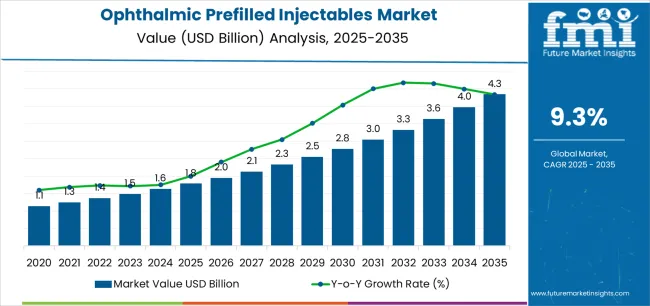
Between 2025 and 2030, the ophthalmic prefilled injectables market is projected to expand from USD 1,784.6 million to USD 2,871.5 million, resulting in a value increase of USD 1,086.9 million, which represents 42.5% of the total forecast growth for the decade. This phase of development will be shaped by increasing adoption of biologic anti-VEGF systems, rising demand for retinal disorder treatment solutions, and growing emphasis on clinical precision features with enhanced therapeutic characteristics. Healthcare facilities are expanding their ophthalmic capabilities to address the growing demand for specialized injectable implementations, advanced therapeutic options, and patient-specific offerings across clinical segments.
| Metric | Value |
|---|---|
| Estimated Value (2025E) | USD 1,784.6 million |
| Forecast Value (2035F) | USD 4,342 million |
| Forecast CAGR (2025-2035) | 9.30% |
From 2030 to 2035, the market is forecast to grow from USD 2,871.5 million to USD 4,342 million, adding another USD 1,470.5 million, which constitutes 57.5% of the overall ten-year expansion. This period is expected to be characterized by the expansion of hospital applications, the integration of innovative biologic solutions, and the development of specialized injectable implementations with enhanced therapeutic profiles and extended clinical capabilities. The growing adoption of advanced delivery formulations will drive demand for ophthalmic prefilled injectables with superior therapeutic characteristics and compatibility with modern ophthalmic technologies across clinical operations.
Between 2020 and 2025, the ophthalmic prefilled injectables market experienced robust growth, driven by increasing demand for biologic anti-VEGF systems and growing recognition of targeted therapeutic technologies as essential components for modern retinal care and ophthalmic surgery across clinical and hospital applications. The market developed as healthcare providers recognized the potential for prefilled injectable solutions to provide both therapeutic benefits and operational advantages while enabling streamlined treatment protocols. Clinical advancement in delivery approaches and evidence-based development began emphasizing the critical importance of maintaining therapeutic efficacy and patient safety in diverse ophthalmic environments.
Market expansion is being supported by the increasing global prevalence of retinal disorders and the corresponding need for injectable technologies that can provide superior therapeutic benefits and clinical advantages while enabling enhanced patient outcomes and extended compatibility across various ophthalmology clinic and hospital applications. Modern ophthalmic specialists and healthcare providers are increasingly focused on implementing proven delivery technologies that can deliver effective targeted therapy, minimize traditional injection limitations, and provide consistent clinical performance throughout complex treatment configurations and diverse patient conditions. Ophthalmic prefilled injectables proven ability to deliver exceptional therapeutic precision against traditional alternatives, enable advanced clinical integration, and support modern treatment protocols makes it an essential component for contemporary ophthalmology and surgical care operations.
The growing emphasis on retinal disease management and therapeutic optimization is driving demand for injectable systems that can support complex treatment requirements, improve patient outcomes, and enable advanced ophthalmic care delivery. Clinical preference for technologies that combine effective targeted therapy with proven safety and therapeutic enhancement benefits is creating opportunities for innovative injectable implementations. The rising influence of aging population trends and retinal disease awareness is also contributing to increased demand for ophthalmic prefilled injectables that can provide advanced features, seamless clinical integration, and reliable performance across extended treatment cycles.
The ophthalmic prefilled injectables market is poised for robust growth and clinical advancement. As healthcare facilities across North America, Europe, Asia-Pacific, and emerging markets seek treatments that deliver exceptional therapeutic characteristics, advanced delivery capabilities, and reliable clinical options, injectable solutions are gaining prominence not just as specialty pharmaceuticals but as strategic enablers of retinal technologies and advanced ophthalmic functionality.
Rising biologic anti-VEGF adoption in ophthalmology applications and expanding retinal treatment initiatives globally amplify demand, while developers are leveraging innovations in therapeutic engineering, advanced delivery integration, and clinical optimization technologies.
The market is segmented by drug class, indication, end user, and region. By drug class, the market is divided into biologic anti-VEGF agents, antibiotic injectables, and ophthalmic viscosurgical devices categories. By indication, it covers retinal vascular disorders, cataract surgery adjuncts, and others segments. By end user, it encompasses ophthalmology clinics, hospitals, ambulatory surgical centers, and others segments. Regionally, the market is divided into North America, Europe, East Asia, South Asia & Pacific, Latin America, and the Middle East & Africa.
The biologic anti-VEGF agents segment is projected to account for 55.6% of the ophthalmic prefilled injectables market in 2025, reaffirming its position as the leading drug class category. Healthcare facilities and ophthalmic integrators increasingly utilize anti-VEGF implementations for their superior therapeutic characteristics when operating across diverse treatment platforms, excellent efficacy properties, and widespread acceptance in applications ranging from basic retinal care to premium surgical operations. Anti-VEGF technology's established clinical methods and proven therapeutic capabilities directly address the facility requirements for dependable injectable solutions in complex ophthalmic environments.
This drug class segment forms the foundation of modern ophthalmology adoption patterns, as it represents the implementation with the greatest market penetration and established physician acceptance across multiple treatment categories and patient segments. Facility investments in anti-VEGF standardization and therapeutic consistency continue to strengthen adoption among ophthalmology providers and hospital systems. With clinicians prioritizing therapeutic efficacy and patient outcomes, anti-VEGF implementations align with both functionality preferences and cost expectations, making them the central component of comprehensive retinal treatment strategies.
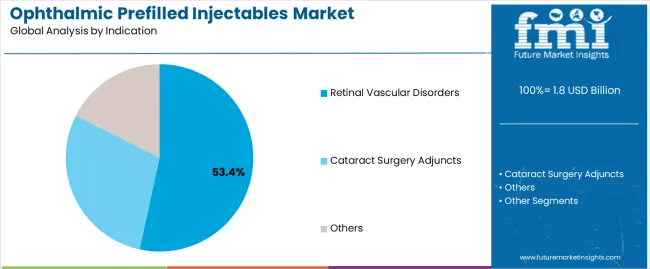
Retinal vascular disorder applications are projected to represent 53.4% of ophthalmic prefilled injectables demand in 2025, underscoring their critical role as the primary indication type for therapeutic delivery across retinal care operations. Healthcare facilities prefer prefilled injectables for retinal disorder treatment for their exceptional therapeutic characteristics, scalable treatment options, and ability to enhance patient outcomes while ensuring consistent therapeutic quality throughout diverse clinical platforms and retinal operations. Positioned as essential therapeutic components for modern retinal care systems, injectable solutions offer both technological advantages and clinical efficiency benefits.
The segment is supported by continuous innovation in retinal technologies and the growing availability of specialized implementations that enable diverse treatment requirements with enhanced therapeutic uniformity and extended patient benefit capabilities. Additionally, healthcare facilities are investing in advanced technologies to support large-scale treatment integration and therapy development. As retinal disease management trends become more prevalent and therapeutic awareness increases, retinal vascular disorder applications will continue to represent a major implementation market while supporting advanced clinical utilization and technology integration strategies.
The ophthalmology clinics segment is expected to capture 45.2% of the ophthalmic prefilled injectables market in 2025, driven by increasing demand for specialized treatment systems that enhance clinical outcomes while maintaining procedural efficiency. Ophthalmology clinics are increasingly adopting prefilled injectables for retinal treatments, surgical procedures, and chronic eye disease management due to their superior dosing accuracy and clinical convenience benefits. The segment benefits from growing specialized ophthalmic care requirements and continuous innovation in injectable formulations tailored for clinic applications.
The ophthalmic prefilled injectables market is advancing steadily due to increasing prevalence of retinal diseases and growing adoption of injectable technologies that provide superior therapeutic characteristics and clinical benefits while enabling enhanced patient outcomes across diverse ophthalmology clinic and hospital applications. The market faces challenges, including complex regulatory requirements for ophthalmic drugs, evolving safety standards, and the need for specialized clinical expertise and treatment programs. Innovation in therapeutic approaches and advanced delivery systems continues to influence product development and market expansion patterns.
The growing adoption of advanced retinal treatment solutions, sophisticated therapeutic capabilities, and clinical outcome awareness is enabling pharmaceutical developers to produce advanced injectable solutions with superior therapeutic positioning, enhanced delivery profiles, and seamless integration functionalities. Advanced retinal disease systems provide improved patient outcomes while allowing more efficient clinical workflows and reliable performance across various ophthalmic applications and treatment conditions. Developers are increasingly recognizing the competitive advantages of clinical integration capabilities for market differentiation and therapeutic positioning.
Modern pharmaceutical manufacturers are incorporating advanced delivery technology, therapeutic integration, and sophisticated clinical solutions to enhance product appeal, enable intelligent dosing features, and deliver value-added solutions to ophthalmic customers. These technologies improve injectable performance while enabling new market opportunities, including multi-therapeutic delivery systems, optimized biologic treatments, and enhanced clinical characteristics. Advanced therapeutic integration also allows developers to support comprehensive ophthalmic technologies and market expansion beyond traditional injectable approaches.
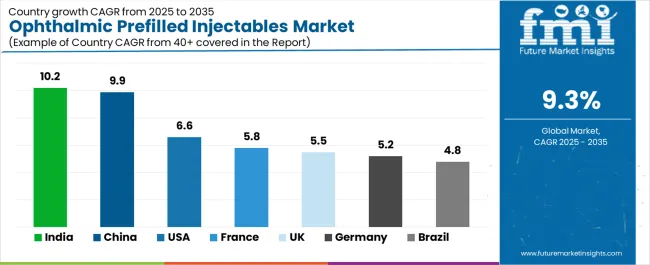
| Country | CAGR (2025-2035) |
|---|---|
| India | 10.2% |
| China | 9.9% |
| USA | 6.6% |
| France | 5.8% |
| UK | 5.5% |
| Germany | 5.2% |
| Brazil | 4.8% |
The ophthalmic prefilled injectables market is experiencing strong growth globally, with India leading at a 10.2% CAGR through 2035, driven by expanding healthcare infrastructure, growing retinal disease awareness programs, and significant investment in ophthalmic care development. China follows at 9.9%, supported by increasing healthcare modernization, growing therapeutic integration patterns, and expanding pharmaceutical infrastructure. The USA shows growth at 6.6%, emphasizing clinical innovation leadership and ophthalmic development. France records 5.8%, focusing on expanding specialty care capabilities and therapeutic technology modernization. The UK exhibits 5.5% growth, emphasizing clinical excellence and premium ophthalmic development. Germany demonstrates 5.2% growth, prioritizing advanced healthcare technology development and quality-focused clinical patterns. Brazil shows 4.8% growth, supported by healthcare expansion initiatives and ophthalmic care development.
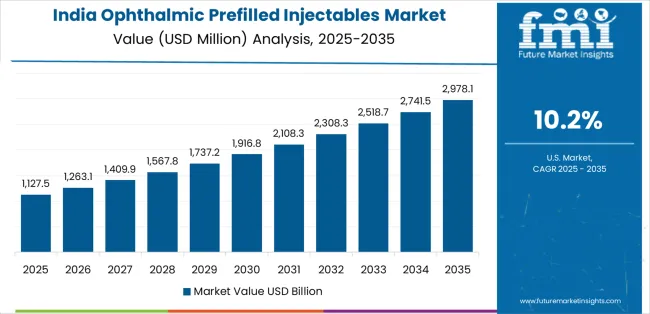
Revenue from ophthalmic prefilled injectables in India is projected to exhibit robust growth with a CAGR of 10.2% through 2035, driven by expanding healthcare infrastructure capacity and rapidly growing retinal disease awareness supported by government initiatives promoting specialty care development. The country's improving ophthalmic care delivery and increasing investment in therapeutic infrastructure are creating substantial demand for advanced injectable implementations. Major healthcare facilities and pharmaceutical companies are establishing comprehensive treatment capabilities to serve both urban clinical demand and expanding rural healthcare markets.
Government support for healthcare accessibility initiatives and ophthalmic development is driving demand for advanced injectable systems throughout major healthcare regions and clinical centers across the country. Strong healthcare growth and an expanding network of specialty-focused providers are supporting the rapid adoption of ophthalmic prefilled injectables among facilities seeking advanced therapeutic capabilities and integrated delivery technologies.
Revenue from ophthalmic prefilled injectables in China is growing at a CAGR of 9.9%, driven by the country's expanding healthcare sector, growing aging population, and increasing adoption of advanced therapeutic technologies. The country's initiatives promoting healthcare modernization and growing ophthalmic development awareness are driving requirements for technology-integrated therapeutic systems. International injectable providers and domestic pharmaceutical companies are establishing extensive clinical and integration capabilities to address the growing demand for advanced therapeutic solutions.
Strong healthcare expansion and expanding modern clinical operations are driving adoption of integrated therapeutic systems with superior injectable capabilities and advanced integration among large healthcare providers and progressive clinical operations. Growing technology diversity and increasing healthcare enhancement adoption are supporting market expansion for advanced injectable implementations with seamless integration profiles and modern therapeutic delivery throughout the country's healthcare regions. China's strategic healthcare position and expanding patient base make it an attractive destination for injectable development facilities serving both domestic and Asian markets.
Revenue from ophthalmic prefilled injectables in the USA is growing at a CAGR of 6.6%, driven by the country's focus on clinical innovation advancement, emphasis on premium therapeutic innovation, and strong position in ophthalmic development. The USA's established clinical excellence capabilities and commitment to technology diversification are supporting investment in specialized injectable technologies throughout major clinical regions. Industry leaders are establishing comprehensive technology integration systems to serve domestic premium ophthalmic production and enhancement applications.
Innovations in therapeutic platforms and clinical integration capabilities are creating demand for advanced injectable implementations with exceptional therapeutic properties among progressive ophthalmic facilities seeking enhanced technology differentiation and patient appeal. Growing premium clinical adoption and increasing focus on therapeutic innovation are driving adoption of advanced injectable platforms with integrated therapeutic delivery and clinical optimization across ophthalmic enterprises throughout the country.
Revenue from ophthalmic prefilled injectables in France is growing at a CAGR of 5.8%, driven by the country's established healthcare sector, growing specialty care programs, and increasing investment in therapeutic development. France's mature healthcare system and commitment to clinical excellence are supporting demand for diverse injectable solutions across multiple specialty segments. Healthcare providers are establishing comprehensive treatment capabilities to serve the growing domestic market and expanding specialty opportunities.
Strong specialty care expansion and expanding modern clinical operations are driving adoption of integrated therapeutic systems with superior injectable capabilities and advanced integration among large healthcare providers and progressive specialty operations. Growing clinical diversity and increasing healthcare enhancement adoption are supporting market expansion for advanced injectable implementations with seamless integration profiles and modern therapeutic delivery throughout the country's healthcare regions.
Revenue from ophthalmic prefilled injectables in the UK is growing at a CAGR of 5.5%, driven by the country's focus on clinical advancement, emphasis on premium therapeutic innovation, and strong position in ophthalmic development. The UK's established clinical excellence capabilities and commitment to technology diversification are supporting investment in specialized injectable technologies throughout major healthcare regions. Clinical leaders are establishing comprehensive technology integration systems to serve domestic premium clinical production and enhancement applications.
Innovations in therapeutic platforms and clinical integration capabilities are creating demand for advanced injectable implementations with exceptional therapeutic properties among progressive ophthalmic facilities seeking enhanced technology differentiation and patient appeal. Growing premium clinical adoption and increasing focus on therapeutic innovation are driving adoption of advanced injectable platforms with integrated therapeutic delivery and clinical optimization across healthcare enterprises throughout the country.
Revenue from ophthalmic prefilled injectables in Germany is expanding at a CAGR of 5.2%, supported by the country's healthcare excellence initiatives, growing quality technology sector, and strategic emphasis on advanced clinical development. Germany's advanced quality control capabilities and integrated healthcare systems are driving demand for high-quality injectable platforms in premium applications, clinical technology, and advanced therapeutic applications. Leading facilities are investing in specialized capabilities to serve the stringent requirements of technology-focused healthcare and premium clinical providers.
Quality clinical advancement and technology-focused development are creating requirements for specialized injectable solutions with superior quality integration, exceptional therapeutic capabilities, and advanced clinical features among quality-conscious healthcare operations and premium clinical providers. Strong position in healthcare technology innovation is supporting adoption of advanced injectable systems with validated therapeutic characteristics and quality integration capabilities throughout the country's healthcare technology sector.
Revenue from ophthalmic prefilled injectables in Brazil is growing at a CAGR of 4.8%, driven by the country's expanding healthcare sector, growing ophthalmic care programs, and increasing investment in therapeutic technology development. Brazil's large healthcare market and commitment to clinical advancement are supporting demand for diverse injectable solutions across multiple therapeutic segments. Healthcare providers are establishing comprehensive treatment capabilities to serve the growing domestic market and expanding clinical opportunities.
Strong healthcare expansion and expanding modern clinical operations are driving adoption of integrated therapeutic systems with superior injectable capabilities and advanced integration among large healthcare providers and progressive clinical operations. Growing technology diversity and increasing healthcare enhancement adoption are supporting market expansion for advanced injectable implementations with seamless integration profiles and modern therapeutic delivery throughout the country's healthcare regions.
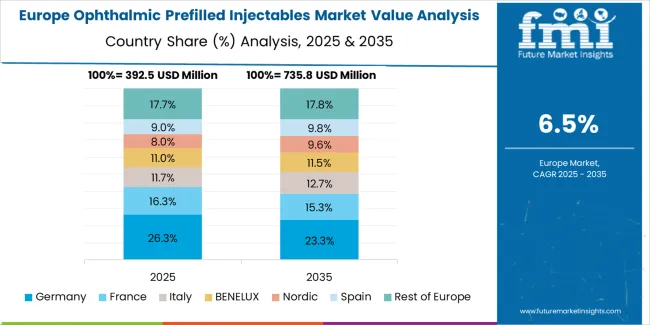
The ophthalmic prefilled injectables market in Europe is projected to grow from USD 509.9 million in 2025 to USD 880.7 million by 2035, registering a CAGR of 5.6% over the forecast period. Germany is expected to maintain its leadership position with a 26.7% market share in 2025, declining slightly to 25.7% by 2035, supported by its strong clinical excellence culture, sophisticated ophthalmic care capabilities, and comprehensive healthcare sector serving diverse injectable applications across Europe.
France follows with a 18.2% share in 2025, projected to reach 18.5% by 2035, driven by robust demand for specialty care technologies in clinical applications, advanced ophthalmic development programs, and therapeutic markets, combined with established healthcare infrastructure and technology integration expertise. Spain holds a 15% share in 2025, expected to reach 16.8% by 2035, supported by growing ophthalmic care activities. Italy commands a 7.2% share in 2025, projected to reach 7.8% by 2035, while BENELUX accounts for 6.1% in 2025, expected to reach 5.9% by 2035. Nordic Countries maintain a 4.3% share in 2025, declining to 3.9% by 2035. The Rest of Western Europe region is anticipated to maintain momentum, with its collective share moving from 22.6% to 21.3% by 2035, attributed to increasing clinical modernization and growing technology penetration implementing advanced therapeutic programs.
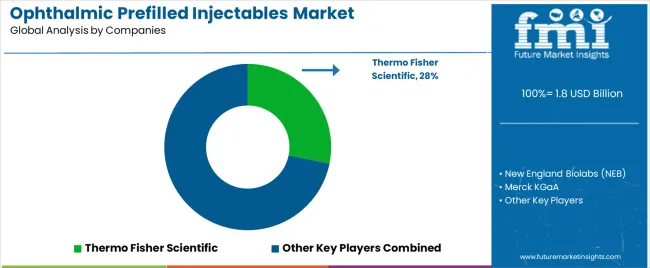
The ophthalmic prefilled injectables market is characterized by competition among established pharmaceutical companies, specialized ophthalmic manufacturers, and integrated therapeutic solution providers. Companies are investing in therapeutic research, delivery optimization, advanced clinical system development, and comprehensive injectable portfolios to deliver consistent, high-quality, and patient-specific therapeutic solutions. Innovation in advanced delivery integration, therapeutic enhancement, and clinical compatibility improvement is central to strengthening market position and competitive advantage.
Thermo Fisher Scientific leads the market with a 28.2% market share, offering comprehensive therapeutic solutions including quality delivery platforms and advanced injectable systems with a focus on premium and clinical applications. New England Biolabs provides specialized biotechnology capabilities with an emphasis on advanced injectable implementations and innovative therapeutic solutions. Merck KGaA delivers comprehensive pharmaceutical services with a focus on integrated platforms and large-scale clinical applications. Promega Corporation specializes in advanced biotechnology technologies and specialized injectable implementations for premium applications. TriLinkBioTechnologies focuses on clinical-oriented therapeutic integration and innovative biotechnology solutions.
The competitive landscape is further strengthened by companies like QIAGEN N.V., which brings expertise in advanced molecular diagnostics and biotechnology solutions for specialized applications. These companies continue to invest in research and development, strategic partnerships, and manufacturing capacity expansion to maintain their market positions and capture emerging opportunities in the growing ophthalmic prefilled injectables sector. The market benefits from continuous innovation in therapeutic technologies, expanding clinical networks, and increasing healthcare facility adoption of prefilled injectable solutions.
| Item | Value |
|---|---|
| Quantitative Units | USD 1,784.6 m illion |
| Drug Class | Biologic Anti-VEGF Agents; Antibiotic Injectables ; Ophthalmic Viscosurgical Devices (OVDs) |
| Indication | Retinal Vascular Disorders; Cataract Surgery Adjuncts; Others |
| End User | Ophthalmology Clinics; Hospitals; Ambulatory Surgical Centers (ASCs); Others |
| Regions Covered | North America; Europe; East Asia; South Asia & Pacific; Latin America; Middle East & Africa |
| Countries Covered | USA; Germany; France; UK; Japan; China; India; South Korea; Brazil; and 40+ additional countries |
| Key Companies Profiled | Thermo Fisher Scientific; New England Biolabs ; Merck KGaA ; Promega Corporation; TriLink BioTechnologies ; QIAGEN N.V. |
| Additional Attributes | Dollar sales by drug class and indication category; regional demand trends; competitive landscape; technological advancements in delivery engineering; advanced therapeutic development; clinical innovation; healthcare integration protocols |
The global ophthalmic prefilled injectables market is estimated to be valued at USD 1.8 billion in 2025.
The market size for the ophthalmic prefilled injectables market is projected to reach USD 4.3 billion by 2035.
The ophthalmic prefilled injectables market is expected to grow at a 9.3% CAGR between 2025 and 2035.
The key product types in ophthalmic prefilled injectables market are biologic anti-vegf agents, antibiotic injectables and ophthalmic viscosurgical devices (ovds).
In terms of indication, retinal vascular disorders segment to command 53.4% share in the ophthalmic prefilled injectables market in 2025.






Full Research Suite comprises of:
Market outlook & trends analysis
Interviews & case studies
Strategic recommendations
Vendor profiles & capabilities analysis
5-year forecasts
8 regions and 60+ country-level data splits
Market segment data splits
12 months of continuous data updates
DELIVERED AS:
PDF EXCEL ONLINE
Ophthalmic Stereoscopic 3D Display Market Size and Share Forecast and Outlook 2025 to 2035
Ophthalmic Drug Packaging Market Forecast and Outlook 2025 to 2035
Ophthalmic Surgical Market Size and Share Forecast Outlook 2025 to 2035
Ophthalmic Injectable Market Size and Share Forecast Outlook 2025 to 2035
Ophthalmic Sprays Market Size and Share Forecast Outlook 2025 to 2035
Ophthalmic Diagnostic Equipment Market Analysis - Size, Share & Forecast 2025-2035
Ophthalmic Tonometers Market – Demand, Growth & Forecast 2025 to 2035
Ophthalmic Lasers Market Analysis - Innovations & Forecast 2024 to 2034
Global Ophthalmic Combination Product Market Analysis – Size, Share & Forecast 2024-2034
Ophthalmic Eye Drop Market – Trends & Forecast 2024-2034
Ophthalmic Knives Market
Ophthalmic Viscosurgical Devices Market
Herpes Zoster Ophthalmicus Market Size and Share Forecast Outlook 2025 to 2035
Excimer and Femtosecond Ophthalmic Lasers Market Size and Share Forecast Outlook 2025 to 2035
Global Prefilled Formalin Vials Market Trends – Size, Share & Growth 2025 to 2035
Prefilled Syringe Drug Molecule Market Analysis - Size, Share, and Forecast 2025 to 2035
Europe Glass Prefilled Syringes and Glass Vials Packaging Equipment Market Analysis – Outlook & Forecast 2025–2035
Polymer-based Prefilled Syringe Market Size and Share Forecast Outlook 2025 to 2035
Image-Guided Injectables Market Forecast and Outlook 2025 to 2035
Microparticle Injectables Market

Thank you!
You will receive an email from our Business Development Manager. Please be sure to check your SPAM/JUNK folder too.
Chat With
MaRIA